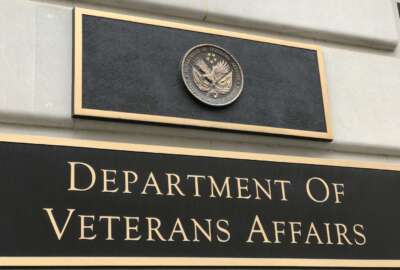Most VA sites scheduling more medical appointments through ‘access sprints’
The VA announced Tuesday it saw 25,000 more patients between October 2023 and February 2024, compared to the same period in fiscal 2023.
The Department of Veterans Affairs is scheduling more medical appointments with veterans at a vast majority of its health care facilities, following recent efforts to boost workforce productivity.
The VA saw 25,000 more patients so far in fiscal 2024, compared to the same period in fiscal 2023. New patient appointments also increased by 11% during this period.
The department says 81% of VA medical centers have seen more new patients so far this year, compared to last year.
VA credits a higher volume of medical appointments with recent historic hiring efforts.
The Veterans Health Administration hired more than 61,000 employees in fiscal 2023, its fastest growth rate in 15 years. The agency grew its total workforce by more than 7%, and now has more than 400,000 employees for the first time in its history.
VHA also launched “access sprints” in January, with a focus on increasing appointment availability across three areas of care — cardiology, mental health and gastroenterology.
VA Under Secretary for Health Shereef Elnahal told reporters on Tuesday that every VA medical center is looking at ways to keep this level of appointment growth sustainable in the long term, beyond the access sprints.
“Hopefully a lot of that will stay in place. We have to be mindful of overall staffing, our authorities and our ability to pay things like overtime,” Elnahal said at a press conference at VA headquarters. “Not all of it will be sustained. But we’re asking every medical center and network to look very closely about what we can continue.”
Under the PACT Act, more than 100,000 new veterans have enrolled in VA health care since the legislation was signed in August 2022. That’s out of the more than 500,000 total health care enrollments during the same period.
“We’re expanding access to care, because we know that the influx of new demand for care will be greater because of the PACT Act, because we are welcoming so many more veterans into our doors,” Elnahal said.
Under an accelerated PACT Act implementation timeline, all veterans exposed to toxic substances and other hazards during military service — at home or abroad — became eligible to enroll directly in VA health care without first applying for VA benefits on March 5.
VHA, Elnahal added, will still have the resources it needs to meet higher demand for VA health care, even as the agency prepares to reduce its headcount by roughly 10,000 positions under its 2025 budget request.
Elnahal said the headcount reduction will happen through attrition and “voluntary separation from employment.”
“We’re not considering anything involuntary. We think there is an opportunity to cut our workforce by 10,000, especially in those roles that are not directly veteran-facing,” Elnahal said.
VHA, he added, is more likely to lower its headcount in management and supervisor roles that don’t provide frontline care to veterans.
“That is the category of employees that we think we can attrit down to a level where we’re not compromising capacity for clinical care. And so, we have the room to do that,” Elnahal said.
Elnahal said VHA is “focused overwhelmingly” on making sure workforce retention levels remain high. VHA saw a 20% decrease in turnover between 2022 and 2023.
“We can fill our clinicians’ schedules and we can see those veterans. I’m not concerned about being over capacity, especially when it comes to outpatient services and mental health — key services that we offer,” he added.
VA Secretary Denis McDonough said the VA has “had a good couple of years on hiring nurses,” and credited that success on hiring and retention authorities under the PACT Act.
McDonough also credited increased nurse hiring on the RAISE Act that Congress passed in March 2022. The legislation set high pay caps for VA registered nurses and physician assistants.
He also said he’s heard positive feedback about these changes from VA leaders and employees.
“We had been facing a challenge with retention of everybody, to include very highly compensated specialists, but also especially in this moment of pretty substantial wage growth, frontline providers,” McDonough said. “To hear that testimony about the impact of policy decisions that we’ve taken, and that Congress has taken in the course of the last couple of years, has been really important.”
Despite VHA’s planned headcount reduction, Elnahal said the agency is still looking to hire in a few strategic areas, including mental health care. The agency is also looking to reduce the time it takes to fill vacant positions.
VHA, as of January, took an average 157 days to fill a position once it became vacant. McDonough said he’s “super frustrated at how long it takes to hire,” and has heard those frustrations from VA facilities across the country.
“We lose too many very high-quality and highly qualified providers to our competitors by being slow — and we can’t afford to keep doing that,” McDonough said.
Elnahal said VHA is looking to standardize the hiring process nationwide, and is now holding a “friendly competition” across Veterans Integrated Services Networks (VISNs) to see who can get to the lowest time to fill for critical hires.
“We hope that that will have some benefit here. But we’ve got to get better and we’re very focused on it,” Elnahal said.
VHA task force targets clinician burnout
Elnahal said VHA is taking steps to ensure that, “as we expand the volume of appointments, and offer greater care to veterans across the country, that we protect our clinicians from burnout.”
Michael Charness, chief of staff for the VA Boston Health Care System, is leading VHA efforts to reduce administrative burdens that can contribute to burnout.
“You can’t sprint very far with a heavy backpack, and we were mindful that clinicians everywhere bear heavy administrative burdens,” Charness said. “Many clinicians experience burnout, and reducing administrative burdens is one way to decrease burnout and increase professional fulfillment.”
Charness is leading a task force focused on reducing VHA administrative burdens, based on feedback received from employees.
The task force, he said, learned employees were getting too many “view alerts” on the VA’s Electronic Health Record and getting “inboxes full of clinical messages.”
“Clinical teams manage hundreds of these daily, but some alerts are not clinically important,” Charness said.
The task force, he added, recommended “a few simple tweaks” to the EHR that eliminated clinician view alerts related to appointment scheduling.
“One of the things I hear constantly in the field is the inefficiencies that are created by administrative burden. Efficiency gains are really important for provider morale,” McDonough said. “But ultimately, it also increases their ability to see additional patients.”
Charness said implementing just a few of these changes led to a reduction in view alerts for VA providers in Boston, and that “clinicians notice the difference.”
The task force, he added, is sharing these administrative burden-reduction efforts with VA clinicians across the country.
“Freeing up more time for clinical care will improve clinic access, while increasing clinician engagement in the most rewarding part of their job,” Charness said.
Copyright © 2025 Federal News Network. All rights reserved. This website is not intended for users located within the European Economic Area.
Jory Heckman is a reporter at Federal News Network covering U.S. Postal Service, IRS, big data and technology issues.
Follow @jheckmanWFED






